A clown is funny in the circus ring, but what would be the normal reaction to opening a door at midnight and finding the same clown standing there in the moonlight?
Lon Chaney Sr 1

Australians love fancy dress – from Halloween to Christmas parties, workplace break-ups, Mad Monday or the Melbourne Cup carpark party, we will dress up at the drop of a hat. It’s a chance to get a little creative, a little silly, to step outside our everyday identities and spend some time in someone else’s shoes. Sometimes very big shoes. The State Library Victoria pictures collection contains hundreds of images of clowns, some famous and familiar while other figures are completely anonymous. Let’s dig deep into the archives and take a look at some of those unknown, or lesser known, who have the good fortune to have found a home in the SLV collection.
The image above includes the signature patterned pant and big shoes of the clown as well as an unsettling papier mache head and the unlucky ‘upside down’ horseshoe2. The awkwardness of the figure was captured eloquently by the SLV cataloguer describing this image as “Whole-length, standing, entire boy encased in fat clown costume with checked pants and large checked shoes”. We don’t know who this boy is but we are glad he’s here.
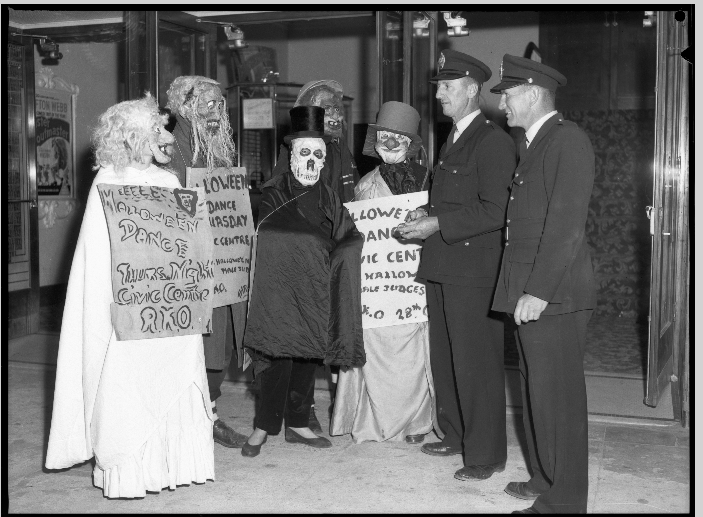
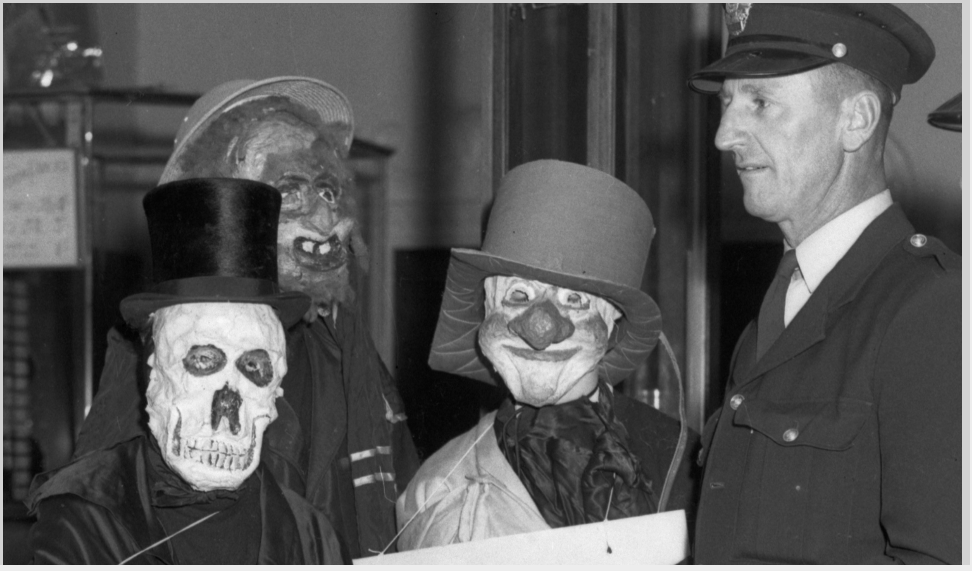
This lovely glass negative from the Riverina Herald collection shows a group of (presumably) youngsters advertising the Halloween Dance at the Civic Centre along with two men in uniforms (likely concierge uniforms). The promoters of the Halloween Dance are in an array of costumes, some a little harder to identify than others(little more inscrutable than others), but in the centre we can see the big red nose and plastered-on smile of a clown. These masks, which look largely home made, feature grins all round but none of them look too cheery, including our friend the clown.
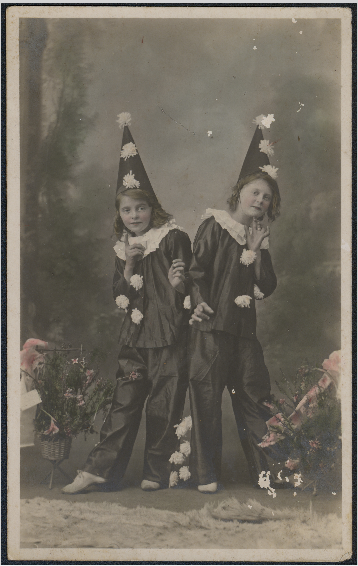
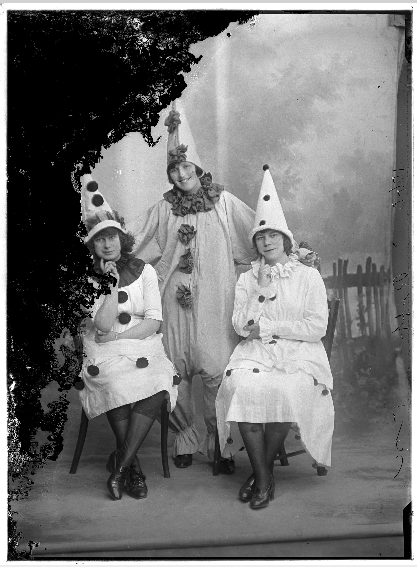
Clowns typified by a red nose, big grin and comically large shoes are know as Auguste Clowns3. Of course, they aren’t the only kind of clown around. Jesters, harlequins and French (also known as White or Pierrot clowns) clowns are also to be found in the collection4. It is this last type of clown that made for a popular costume for children in the late 1800s and the early part of the twentieth century. Characterised by frills, pom poms and often stark white face paint, it was a popular costume for fancy dress and Halloween parties as well as a popular theme for studio portraits.

These nine clowns from a Veuve Cliquot champagne promotion are quintessential White or French clowns, drawing attention to the cultural cache of the French champagne. There is a sense of the mischievous yet melancholy clowns of The Continent.
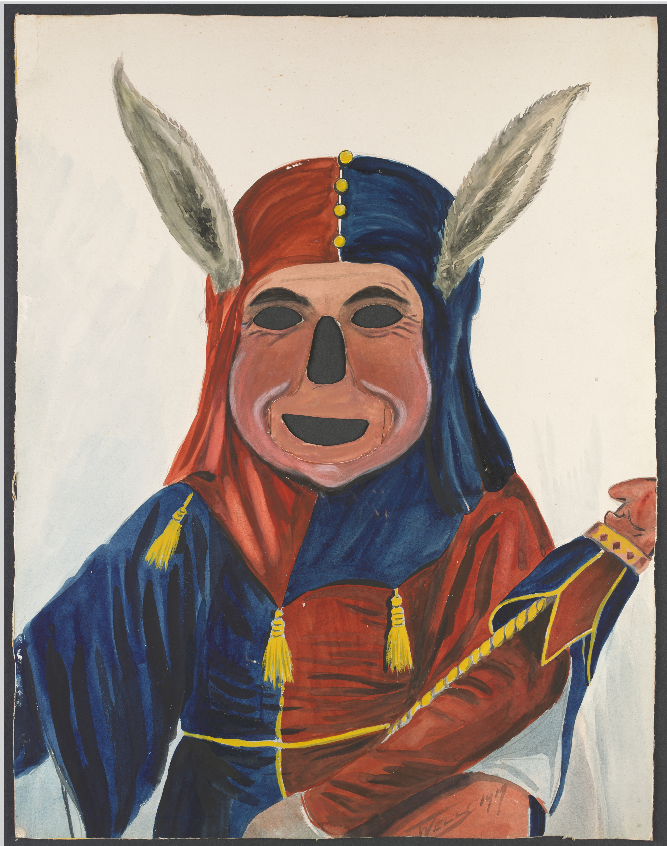

Jesters are some of the oldest form of clown, one which we are often familiar with from depictions of medieval life and from the works of William Shakespeare. This type of clown is typified by the incorporation of bells, pointed headwear and often a variety of colours, which is also found in the harlequin. The Jester often carried a smaller version of himself, helpful for dialogue in what was often a one-man show. The figure on the left above is a mask made for the character of Touchstone, the fool, in Shakespeare’s As you like it. It was one of many masks made by S.G. Wells for famed Melbourne performer Bland Holt.
Whatever kind of clown you enjoy, whatever kind of clown you may be, we hope you enjoyed this exploration of the lesser-known clowns in the State Library collection. Perhaps they can give you some inspiration for Halloween, Cup Day or your next fancy dress occasion.
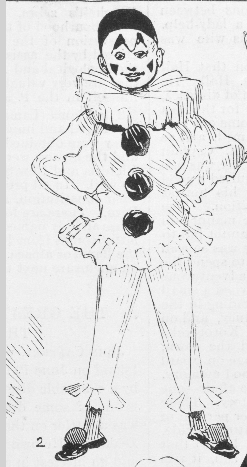
Further reading
For more on Theatre and Performance, see our Theatre and performance in Victoria research guide
For more on costumes, see our Fashion research guide
For more on Magic and Magicians, see our Magic & Magicians research guide
To explore more images, try our copyright-free image search
- Cited in Buick, N & Heller-Nicholas, A, 2017. ‘Horrific transformations: Costume, gender and the Halloween franchise’, p186, in Petrov, J & Whithead, GD, (eds), Fashioning horror: Dressing to kill on screen, Bloomsbury Publishing, New York (available as an ebook to Victorian-registered library members
- Opie, I & Tatem, M, 1992, A Dictionary of Superstition, Oxford University Press, Oxford and New York, p 39
- Davidson J, 2013, Clown: readings in theatre practice, Houndmills, Basingstoke, Hampshire, Palgrave Macmillan, p 65
- As above, p 32


This is such a fun read and there’s lots going on with those images. It makes me curious to learn more. I just revisited the poltergeist movie and that oh so scary clown. Much food for thought! Thanks for the work.